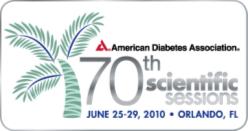いま、1型糖尿病は
2010年07月28日

Though I could not attend all the presentations as many different presentations are given in parallel, I would like to list below some presentations I attended and found interesting.
These presentations include those given during daytime sessions, early-morning sponsored symposiums (for which you have to be at the venue by 5:30am) and evening sponsored symposiums (from 18:00 to 21:00).
Newer antihyperglycemic agent
You may have probably heard of incretin as well as GLP-1. Injectable formulation that has the same action as GLP-1 and oral drug that keeps GLP-1 long in the blood were launched at the end of last year. (They have been used in the U.S. and other countries for several years already.)
These are therapeutic agents for type 2 diabetes, not for type 1 diabetes. Though they may be found useful to treat type 1 diabetes also in the future, they are currently designed for type 2 diabetes. These drugs have been attracting much attention in Japan as revolutionary agents that suppress the rise of postprandial glucose levels with fewer chances of causing hypoglycemia. How do these agents actually reduce blood glucose levels? Will they act continuously even if used over a long period of time? We are very much looking forward to such reports going forward.
Furthermore, a drug related to dopamine (which is a neurotransmitter existing in brain cells and also an adrenaline and noradrenaline precursor) that has been developed as therapeutic agent for type 2 diabetes is already in the market. Dopamine is a well-known neurotransmitter related to feelings of pleasure. The principle of the aforementioned drug is that receptor-bound dopamine increases dopamine action and mitigates insulin resistance. The drug has been reportedly successful in suppressing the onset of cardiovascular diseases in diabetes patients. It will need to be monitored whether it will not be really harmful to the body when used over a long period of time.
Drug related to enzyme existing in kidney tubule is also being developed as therapeutic drug mainly for type 2 diabetes. Sugar in the blood is excreted once from the glomerulus in the kidney, but it has been known that it gets reabsorbed after that through the tubules. The drug being developed suppresses enzyme that plays a role in the reabsorption. Suppressing the enzyme increases blood sugar.
Though there is some concern about possible increase in urinary tract infection, it was reported in the presentation that no problem has been found for now. This is another drug that we should keep giving an eye to.
Development of insulin formulation
I would like to briefly touch on the development of new insulin formulation. Though it is still in the very early stage of development, insulin product that will start acting even faster than the existing super rapid-acting insulin is being developed. Serum insulin level begins to rise scarcely when blood glucose level starts rising, and the idea of this new insulin is to create insulin product that starts acting fast enough.
Meanwhile, insulin product that will act even longer than the existing long-acting soluble insulin is being developed as well. There has even been a report that in a clinical trial on insulin product that keeps acting for three days, it produced the same effects as the existing long-acting soluble insulin administered once a day.
Finally, do you remember that carcinogenicity of long-acting soluble insulin became a hot topic around June last year? One year has passed, and there was a symposium that tried to verify the correlation once again with aplomb. As in the past, the link between hyperglycemia and carcinogenicity is pointed out, but it has been concluded for now that there is no correlation between long-acting soluble insulin and carcinogenicity. In several years, the results of a large study for further verification are supposed to come out. I will provide an update on this topic again.
©2010 Yasuko Uchigata
海外の糖尿病ケアにおける動き―2010年アメリカ糖尿病学会から

多くの発表が平行して行われますので、全部を聴講できていませんが、聴いた限りにおいて、面白かったものを、いくつか、以下に挙げてみます。
これらは、日中の学会での発表と、5時半に間に合うように出かけなければならない早朝スポンサーシンポジウムや学会終了後の夜のスポンサーシンポジウムで(夜6−9時)の講演も含めてのものです。
GLP-1と同じ作用をもった注射製剤や、血中GLP-1を長持ちさせるのみ薬が昨年末から、日本にも登場してきました(すでにアメリカを始め海外では数年前から使用されていました)。
これは、2型糖尿病の治療薬であり、1型糖尿病の治療薬ではありません。将来的には、1型糖尿病にも役立つということがわかるかもしれませんが、いまのところは2型糖尿病の方のお薬です。
食後の血糖値を上昇させないようにする一方で、低血糖はおこしにくい薬ということで、いま、日本では画期的な薬として、注目を浴びています。実際にどのように血糖を下げるのか、長期に使用しても作用がきちんと継続して効くのか、これからの報告に期待がかかります。
さらに、2型糖尿病の治療薬として、脳細胞に存在する神経伝達物質でアドレナリンやノルアドレナリンの前駆物質でもあるドパミンに関連した薬も開発されて、もう市場に出回っているようです。
ドパミンは快の感情に関係する神経伝達物質として有名ですが、この物質が結合する受容体に結合してドパミン作用を増強させる薬が、インスリン抵抗性を緩和させるというリクツです。
糖尿病患者さんの心血管疾患の発症抑制もできたということですが、長く使用してみて、ほんとうに体に害がないか、これから注目していくべきでしょう。
腎臓の尿細管にある酵素に関連した薬も開発中です。これも主に2型糖尿病の治療薬として開発中です。
血中の糖分というのは、腎臓の糸球体というところから一旦は排泄されるのですが、その後尿細管というところから再吸収されていることがわかっていました。この再吸収に担っている酵素を抑制する薬が開発中なのです。
酵素を抑制するわけですので、尿糖が増加することになります。尿路感染症が増加することが懸念されるのですが、いまのところ、問題ないとの報告でした。これも注目していくべき薬です。
普通には血糖上昇するかしないかのときにもう血中インスリン値が上昇しはじめるわけですので、これに準じたインスリンをつくろうではないか、というアイデアから来ています。
一方で、現在みなさんが使用している持効型溶解インスリンよりもっと長く効き続けるインスリンも開発中です。3日間インスリンが効き続けるインスリンの臨床試験では、1日1回の現在の持効型溶解インスリンと同じ効果を示したとの報告もあります。
最後に、昨年の6月ごろ、持効型溶解インスリンと発がん性のことが話題になったことを覚えていますか。1年経過してみて、冷静にもう一度検証してみるシンポジウムもありました。
高血糖と発がん性の関連はこれまで通りですが、持効型溶解インスリンとの関連はやはり問題はないとの結論がでました。
あと数年しますと、さらに確証するに足る大規模調査の結果がでることになっています。また、お知らせします。
※ヘモグロビンA1c(HbA1c)等の表記は記事の公開時期の値を表示しています。
Copyright ©1996-2024 soshinsha. 掲載記事・図表の無断転用を禁じます。
治療や療養についてかかりつけの医師や医療スタッフにご相談ください。

 医療・健康情報グループ検索
医療・健康情報グループ検索